Transfer of Virtual Water of Woody Forest Products from China
Abstract
:1. Introduction
2. Materials and Methods
2.1. Data Source
2.2. VWWFP Export
2.3. VWWFP Import
2.4. VWWFP Trade Balance
2.5. Contribution to China
2.6. VWWFP Trend
3. Results
3.1. Total VWWFP Transfer
3.1.1. Quantity and Structure
3.1.2. Change in Trend
3.2. Transfer Flow
Total VWWFP Transfer Flow
3.3. Contribution of Nations or Continents to China
3.4. VWWFP Transfer Flow Type
4. Discussions
5. Conclusions
Supplementary Materials
Acknowledgements
Author Contributions
Conflicts of Interest
Appendix A
References
- Dalin, C.; Konar, M.; Hanasaki, N.; Rinaldo, A.; Rodriguez-Iturbe, I. Evolution of the global virtual water trade network. Proc. Natl. Acad. Sci. USA 2012, 109, 5989–5994. [Google Scholar] [CrossRef] [PubMed]
- Zhao, X.; Liu, J.G.; Liu, Q.Y.; Tillotson, M.R.; Guan, D.B.; Hubacek, K. Physical and virtual water transfers for regional water stress alleviation in China. Proc. Natl. Acad. Sci. USA 2015, 112, 1031–1035. [Google Scholar] [CrossRef] [PubMed]
- Allan, J.A. Virtual water—The water, food, and trade nexus useful concept or misleading metaphor? Water Int. 2003, 28, 106–113. [Google Scholar] [CrossRef]
- Tamea, S.; Laio, F.; Ridolfi, L. Global effects of local food-production crises: A virtual water perspective. Sci. Rep. 2016, 6, 18803. [Google Scholar] [CrossRef] [PubMed]
- Hoekstra, A.Y. Water Security of Nations: How International Trade Affects National Water Scarcity and Dependency. In Threats to Global Water Security; Jones, J.A.A., Vardanian, T.G., Hakopian, C., Eds.; Springer: Berlin, Germany, 2009; pp. 27–36. [Google Scholar]
- Hoekstra, A.Y.; Chapagain, A.K. The water footprints of Morocco and the Netherlands: Global water use as a result of domestic consumption of agricultural commodities. Ecol. Econ. 2007, 64, 143–151. [Google Scholar] [CrossRef]
- Goswami, P.; Nishad, S.N. Virtual water trade and time scales for loss of water sustainability: A comparative regional analysis. Sci. Rep. 2015, 5. [Google Scholar] [CrossRef] [PubMed]
- Orlowsky, B.; Hoekstra, A.Y.; Gudmundsson, L.; Seneviratne, S.I. Today’s virtual water consumption and trade under future water scarcity. Environ. Res. Lett. 2014, 9. [Google Scholar] [CrossRef]
- Hoekstra, A.Y.; Hung, P.Q. Globalisation of water resources: International virtual water flows in relation to crop trade. Glob. Environ. Chang. 2005, 15, 45–56. [Google Scholar] [CrossRef]
- Seyam, I.M.; Hoekstra, A.Y.; Savenije, H.H.G. Calculation methods to assess the value of upstream water flows and storage as a function of downstream benefits. Phys. Chem. Earth 2002, 27, 977–982. [Google Scholar] [CrossRef]
- Aldaya, M.M.; Hoekstra, A.Y. The water needed for Italians to eat pasta and pizza. Agric. Syst. 2010, 103, 351–360. [Google Scholar] [CrossRef]
- Su, X.L.; Li, J.F.; Singh, V. Optimal Allocation of Agricultural Water Resources Based on Virtual Water Subdivision in Shiyang River Basin. Water Resour. Manag. 2014, 28, 2243–2257. [Google Scholar] [CrossRef]
- Cazcarro, I.; Hoekstra, A.Y.; Choliz, J.S. The water footprint of tourism in Spain. Tour. Manag. 2014, 40, 90–101. [Google Scholar] [CrossRef]
- Hoekstra, A.Y.; Mekonnen, M.M. The water footprint of humanity. Proc. Natl. Acad. Sci. USA 2012, 109, 3232–3237. [Google Scholar] [CrossRef] [PubMed]
- Allan, J.A. Virtual water: A strategic resource global solutions to regional deficits. Ground Water 1998, 36, 545–546. [Google Scholar] [CrossRef]
- Carr, J.A.; D’Odorico, P.; Laio, F.; Ridolfi, L. Recent History and Geography of Virtual Water Trade. PloS ONE 2013, 8, e55825. [Google Scholar] [CrossRef] [PubMed]
- Lu, Y.; Zhang, X.Y.; Chen, S.Y.; Shao, L.W.; Sun, H.Y. Changes in water use efficiency and water footprint in grain production over the past 35 years: A case study in the North China Plain. J. Clean. Prod. 2016, 116, 71–79. [Google Scholar] [CrossRef]
- Chapagain, A.; Hoekstra, A. Water Footprints of Nations; UNESCO-IHE Delft: Delft, The Netherlands, 2004; Volume 1. [Google Scholar]
- Launiainen, S.; Futter, M.N.; Ellison, D.; Clarke, N.; Finer, L.; Hogbom, L.; Lauren, A.; Ring, E. Is the Water Footprint an Appropriate Tool for Forestry and Forest Products: The Fennoscandian Case. Ambio 2014, 43, 244–256. [Google Scholar] [CrossRef] [PubMed]
- Tian, M.H.; Ke, S.F. Virtual water content and trade analysis of primary woody products in China. Int. For. Rev. 2012, 14, 380–390. [Google Scholar] [CrossRef]
- Schyns, J.F.; Booij, M.J.; Hoekstra, A.Y. The water footprint of wood for lumber, pulp, paper, fuel and firewood. Adv. Water Resour. 2017, 107, 490–501. [Google Scholar] [CrossRef]
- China Forestry Administration, China Forestry Statistical Yearbook; China Forestry Press: Beijing, China, 2014; Volume 1993–2014.
- Food and Agriculture Organization of the United Nations (FAO). Global Forestry Product and Trade Statistics; Food and Agriculture Organization (FAO): Rome, Italy, 2014; Volume 1993–2014, Available online: http://www.fao.org/faostat/en/#data (accessed on 8 March 2017).
- Egan, M. The Water Footprint Assessment Manual. Setting the Global Standard. Soc. Environ. Account. J. 2011, 31, 24–25. [Google Scholar] [CrossRef]
- Minghua, T.; Cheng, L.; Qiujie, G. Initial Estimates of Content and Trade of Virtual Water by Woody Forest Products in China. J. Beijing For. Univ. (Soc. Sci.) 2012, 11, 82–87. (In Chinese) [Google Scholar]
- Theil, H. A Rank-Invariant Method of Linear and Polynomial Regression Analysis I–III. Nederl. Akad. Wetensch. Proc. 1950, 12, 345–381. [Google Scholar]
- Sen, P.K. Estimates of the regression coefficient based on Kendall’s tau. J. Am. Stat. Assoc. 1968, 63, 1379–1389. [Google Scholar] [CrossRef]
- Hoaglin, D.C.; Mosteller, F.; Tukey, J.W. Understanding Robust and Exploratory Data Analysis; Hoaglin, D.C., Mosteller, F., Tukey, J.W., Eds.; Wiley: Hoboken, NJ, USA, 2000. [Google Scholar]
- Ran, C.; Jiang, W.; Yuan, L.; Wang, W.; Zhongliang, L.V.; Zheng, C. Inter-annual variations in vegetation and their response to climatic factors in the upper catchments of the Yellow River from 2000 to 2010. J. Geogr. Sci. 2014, 24, 963–979. [Google Scholar]
- Zang, C.F.; Liu, J.G. Trend analysis for the flows of green and blue water in the Heihe River basin, northwestern China. J. Hydrol. 2013, 502, 27–36. [Google Scholar] [CrossRef]
- Chao, M.; Xu, C.X.; Tian, G.L. The virtual water flow in China’s foreign trade of agricultural products. Resour. Sci. 2011, 33, 729–735. [Google Scholar]
- Liu, J.G.; Zang, C.F.; Tian, S.Y.; Liu, J.G.; Yang, H.; Jia, S.F.; You, L.Z.; Liu, B.; Zhang, M. Water conservancy projects in China: Achievements, challenges and way forward. Glob. Environ. Chang. 2013, 23, 633–643. [Google Scholar] [CrossRef]
- Yu, C.Q.; Gong, P.; Yin, Y.Y. China’s water crisis needs more than words. Nature 2011, 470, 307. [Google Scholar] [CrossRef] [PubMed]
- Aeschbach-Hertig, W.; Gleeson, T. Regional strategies for the accelerating global problem of groundwater depletion. Nat. Geosci. 2012, 5, 853–861. [Google Scholar] [CrossRef]
- Huo, X. A study on china’s foreign trade policy of forest products under the new period. Econ. Res. Guide 2015, 2015, 193–195. [Google Scholar]
- Fu, Y.Z.; Chen, B.D. The new trade policy development of main forest woody products trade and countermeasures for China. China Econ. Trade 2012, 2012, 14–19. [Google Scholar]
- Huang, Y.L.; Chen, Y.N.; Li, A.Q. Analysis of trade status and countermeasures of China’ forest woody products after 2008 financial crisis. World Agric. 2012, 2012, 34–37. [Google Scholar]
- Guo, Z.C.; Feng, Y.H.; Gries, T. Changes of China’s agri-food exports to Germany caused by its accession to WTO and the 2008 financial crisis. China Agric. Econ. Rev. 2015, 7, 262–279. [Google Scholar] [CrossRef]
- Zhang, Y.L.; Wang, X.M.; Blake, D.R.; Li, L.F.; Zhang, Z.; Wang, S.Y.; Guo, H.; Lee, F.S.C.; Gao, B.; Chan, L.Y.; et al. Aromatic hydrocarbons as ozone precursors before and after outbreak of the 2008 financial crisis in the Pearl River Delta region, south China. J. Geophys. Res. Atmos 2012, 117. [Google Scholar] [CrossRef]
- Sun, D.; Jin, X.; Wu, Y. On New Asia-Europe Continental Bridge and its Effects on Economic Development of Jiangsu Province; Transactions of Nanjing University of Aeronautics & Astronautics: Nanjing, China, 1994. [Google Scholar]
- Wu, X.Y. Study on the impact of new Eurasian continental bridge transportation on China’s import and export trade. Mod. Bus. Trade Ind. 2012, 20, 56–59. [Google Scholar]
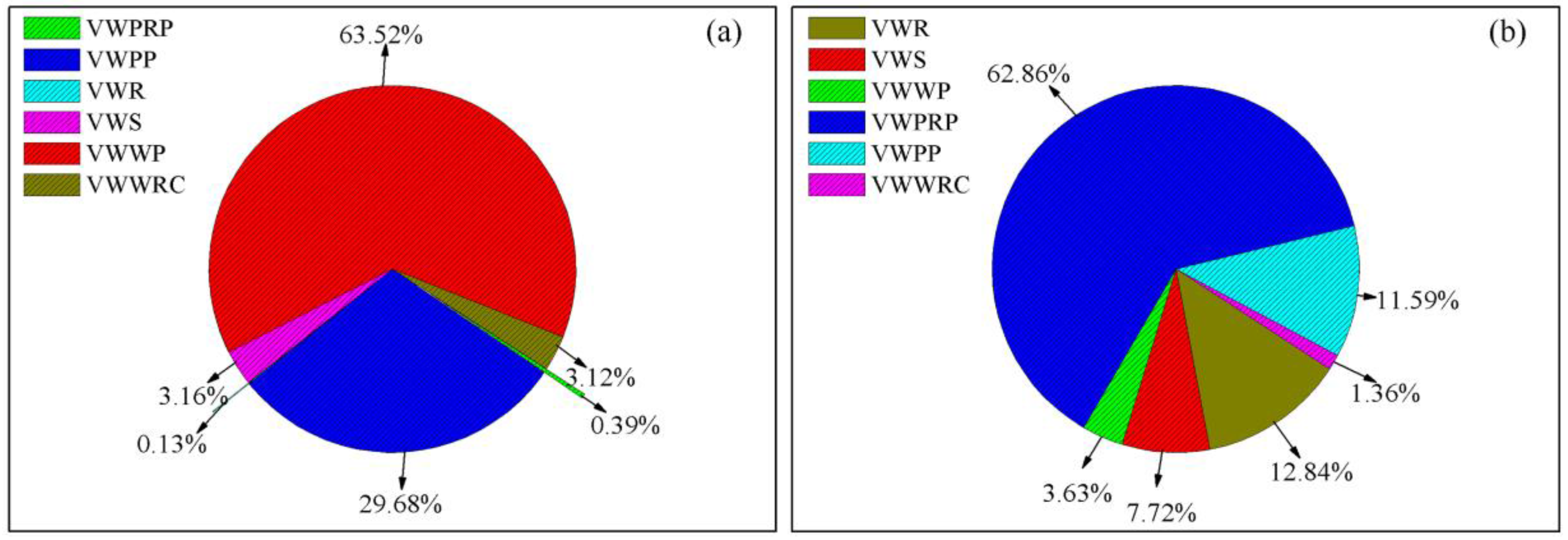
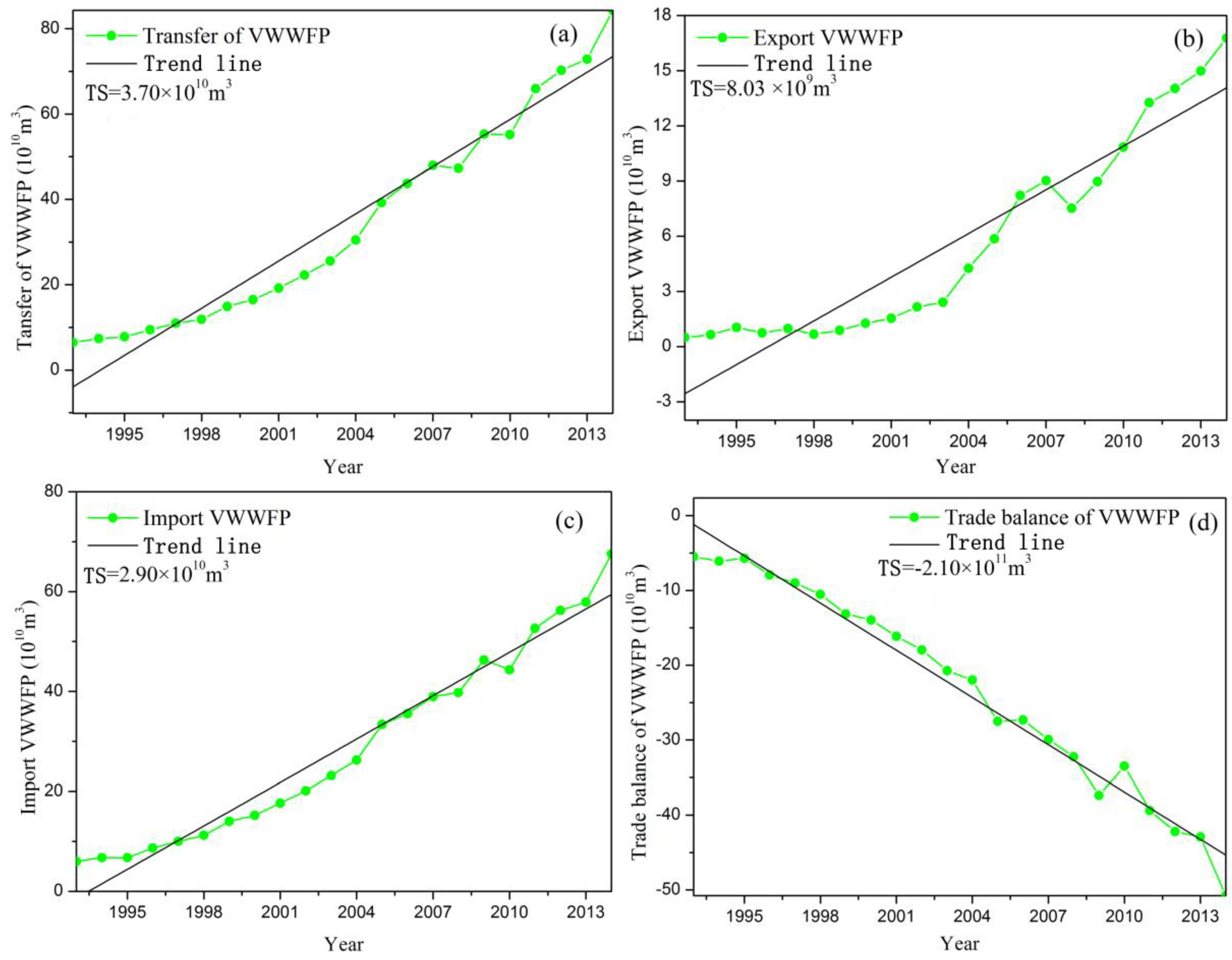
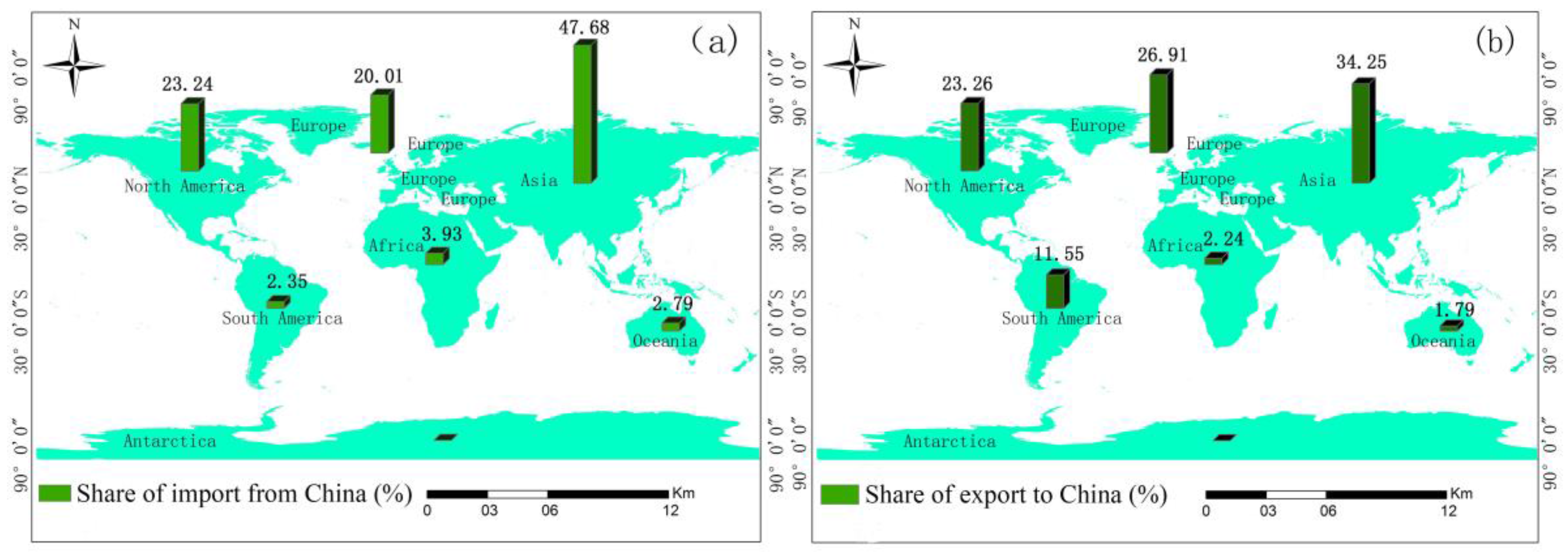
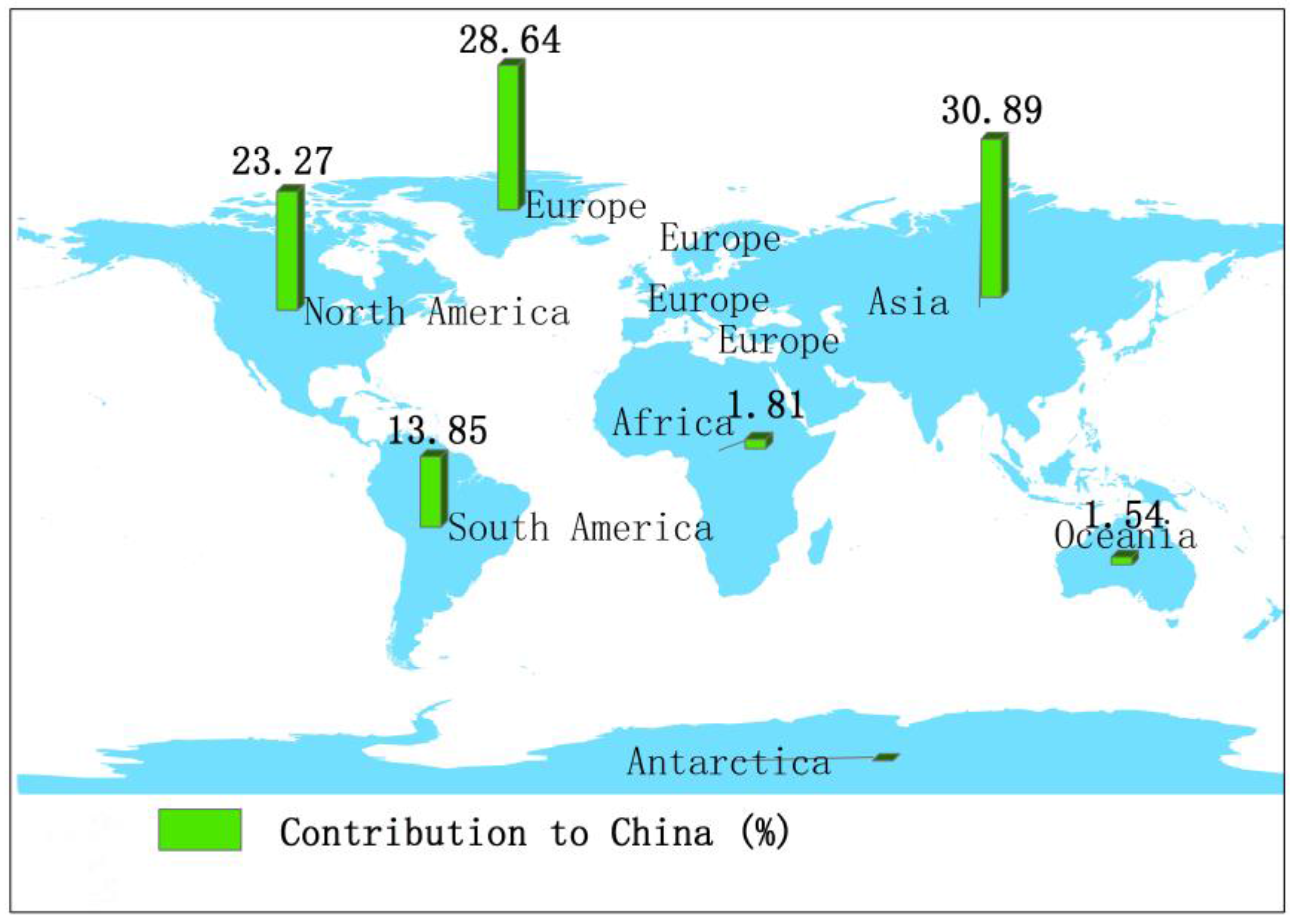
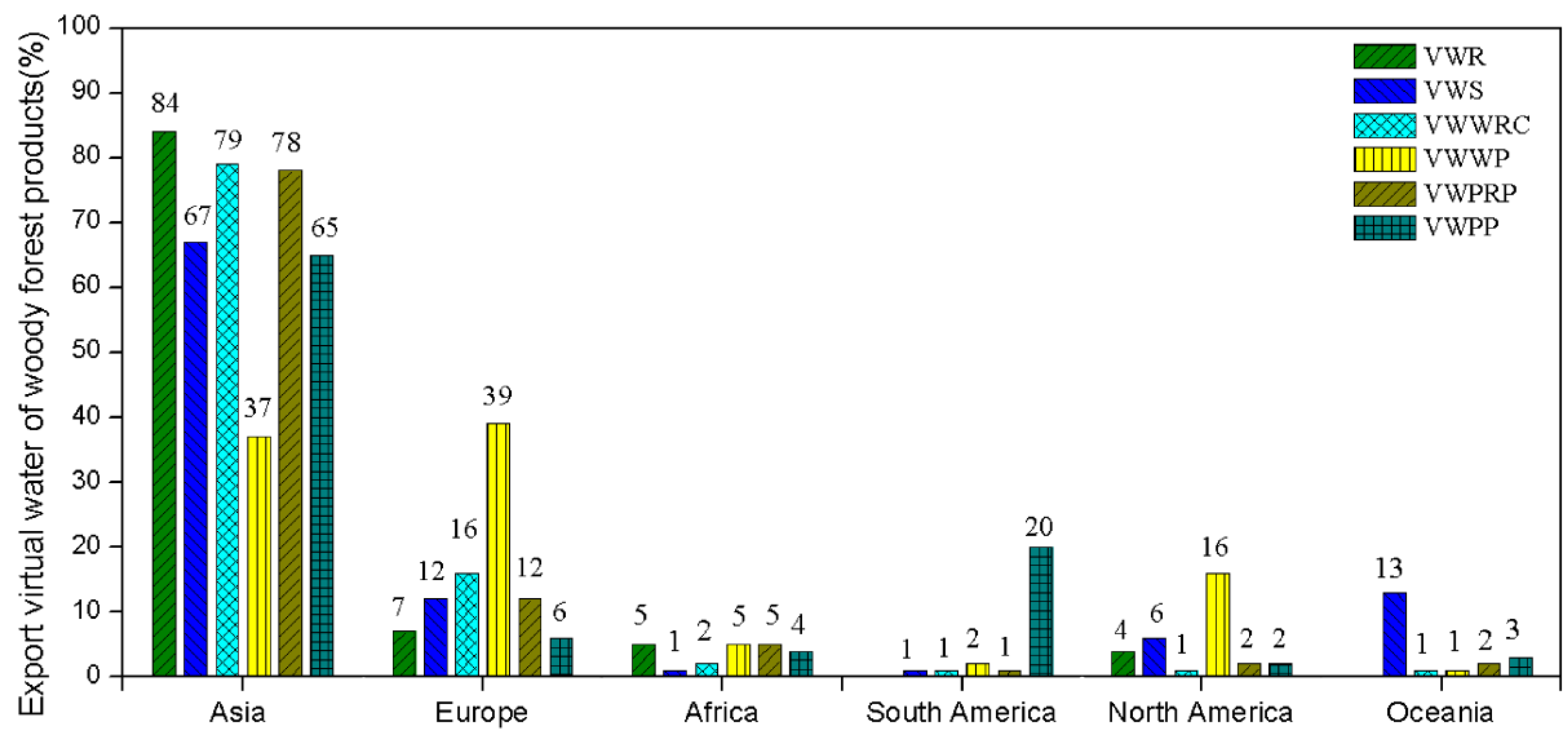
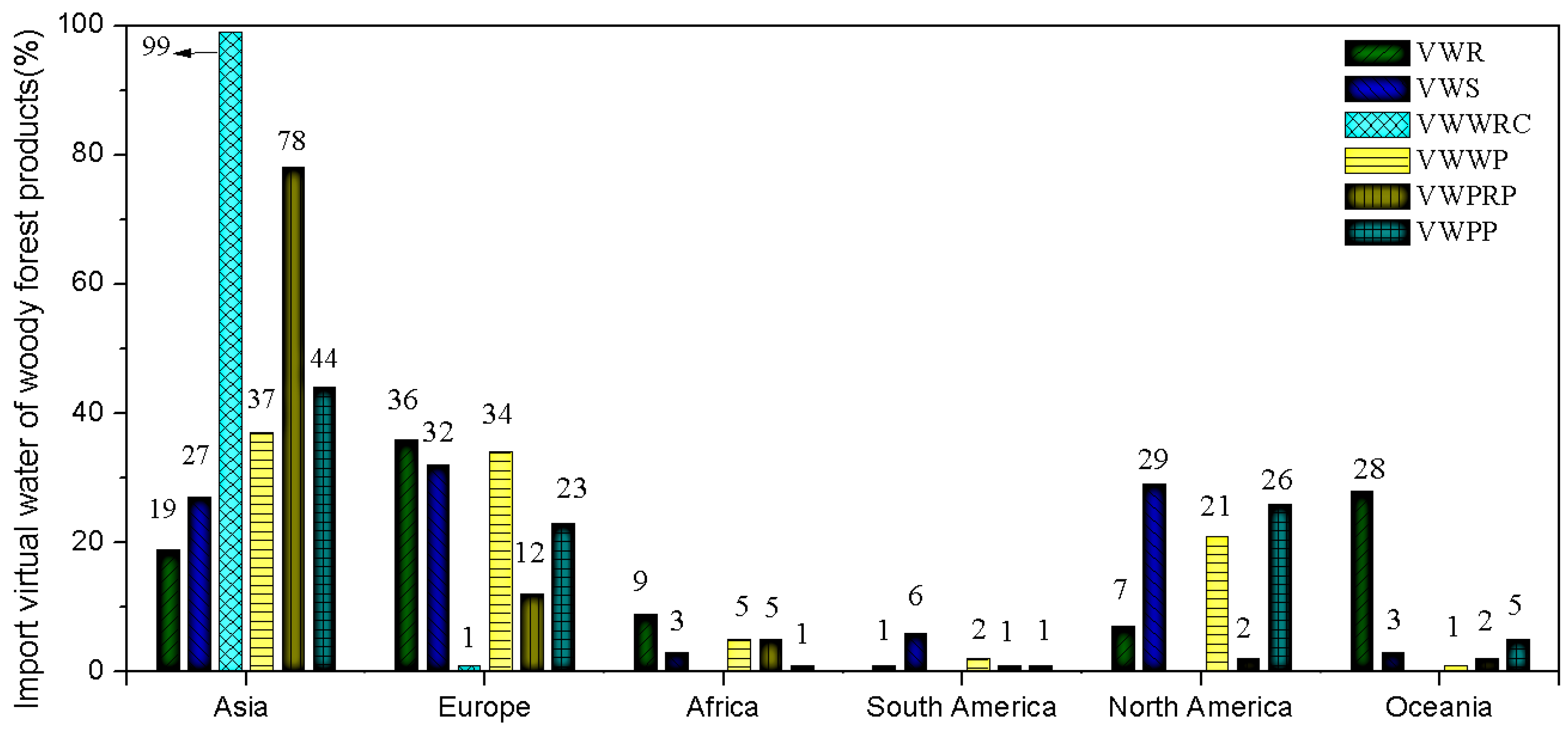
| Virtual Type | Export | Import | Net Export |
|---|---|---|---|
| Virtual water of round-wood (VWR) | 1.63 | 819.56 | −817.93 |
| Virtual water of sawn-wood (VWS) | 39.95 | 480.32 | −440.37 |
| Virtual water of wood residues and wood charcoal (VWWRC) | 39.61 | 83.74 | −44.13 |
| Virtual water of wood-based panels (VWWP) | 804.12 | 206.14 | 597.98 |
| Virtual water of wood pulp and recovered paper (VWPRP) | 4.88 | 4013.27 | −4008.39 |
| Virtual water of paper and paperboard (VWPP) | 375.75 | 733.60 | −357.85 |
| Nation | VWWFP Volume from China (1010 m3) | Share of Import from China (%) | Cumulative Share of Import from China (%) |
|---|---|---|---|
| United States of America | 20.34 | 18.00 | 18.00 |
| Japan | 14.32 | 12.67 | 30.68 |
| Republic of Korea | 7.30 | 6.46 | 37.13 |
| United Kingdom | 5.18 | 4.58 | 41.71 |
| Canada | 4.15 | 3.67 | 45.38 |
| Saudi Arabia | 3.74 | 3.31 | 48.70 |
| India | 3.15 | 2.79 | 51.48 |
| Malaysia | 3.06 | 2.70 | 54.18 |
| Thailand | 2.84 | 2.51 | 56.69 |
| Germany | 2.58 | 2.28 | 58.98 |
| Belgium | 2.56 | 2.26 | 61.24 |
| Total export from China to all other countries | 127 | ||
| Nation | VWWFP Volume to China (1011 m3) | Share of Export to China (%) | Cumulative Share of Export to China (%) |
|---|---|---|---|
| Russian Federation | 8.53 | 13.98 | 13.98 |
| Canada | 7.13 | 11.68 | 25.66 |
| Indonesia | 6.90 | 11.30 | 36.96 |
| United States of America | 6.84 | 11.21 | 48.18 |
| Brazil | 3.69 | 6.04 | 54.22 |
| Malaysia | 3.48 | 5.70 | 59.92 |
| Chile | 2.59 | 4.24 | 64.16 |
| Republic of Korea | 2.37 | 3.88 | 68.04 |
| New Zealand | 2.14 | 3.51 | 71.54 |
| Japan | 1.75 | 2.87 | 74.41 |
| Papua New Guinea | 1.71 | 2.80 | 77.21 |
| Total import from all other countries to China | 634 | ||
© 2018 by the authors. Licensee MDPI, Basel, Switzerland. This article is an open access article distributed under the terms and conditions of the Creative Commons Attribution (CC BY) license (http://creativecommons.org/licenses/by/4.0/).
Share and Cite
Luo, K.; Tao, F.; Moiwo, J.P. Transfer of Virtual Water of Woody Forest Products from China. Sustainability 2018, 10, 410. https://doi.org/10.3390/su10020410
Luo K, Tao F, Moiwo JP. Transfer of Virtual Water of Woody Forest Products from China. Sustainability. 2018; 10(2):410. https://doi.org/10.3390/su10020410
Chicago/Turabian StyleLuo, Kaisheng, Fulu Tao, and Juana P. Moiwo. 2018. "Transfer of Virtual Water of Woody Forest Products from China" Sustainability 10, no. 2: 410. https://doi.org/10.3390/su10020410
APA StyleLuo, K., Tao, F., & Moiwo, J. P. (2018). Transfer of Virtual Water of Woody Forest Products from China. Sustainability, 10(2), 410. https://doi.org/10.3390/su10020410





